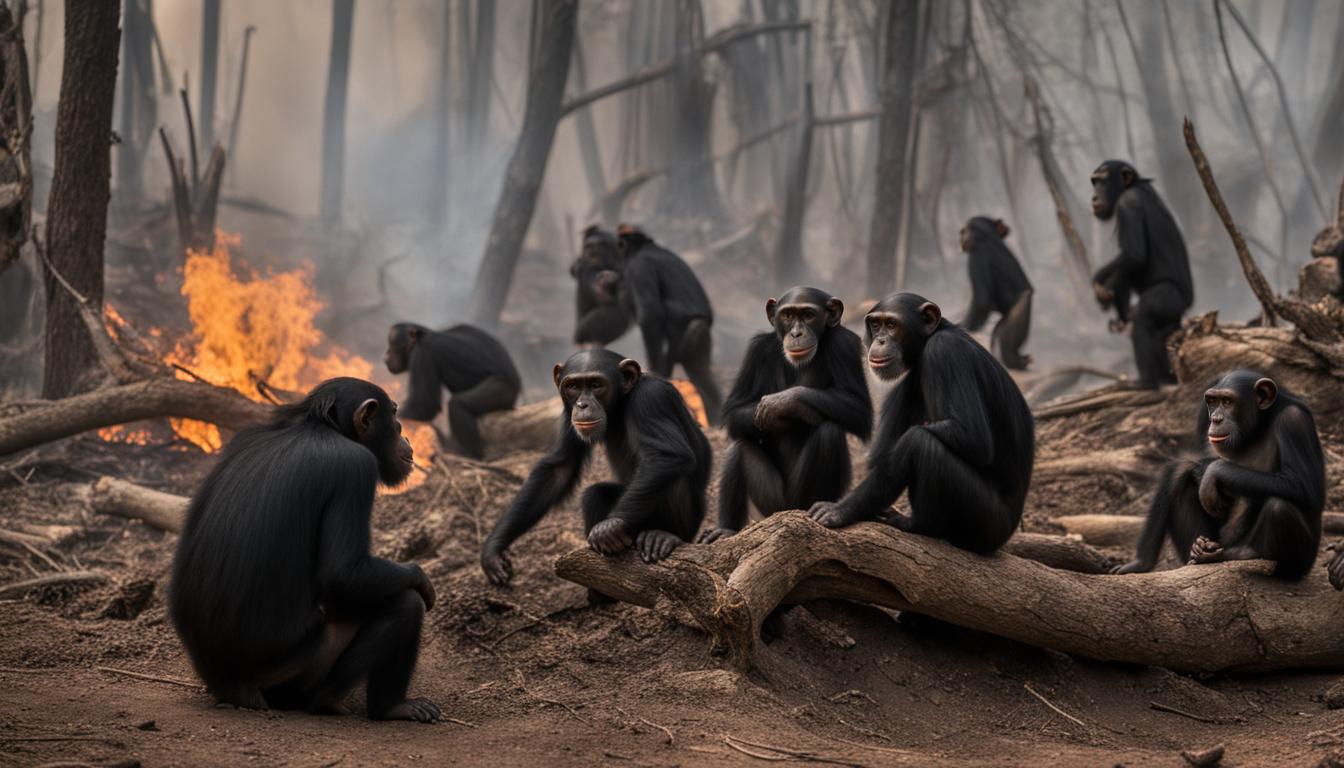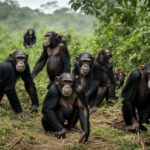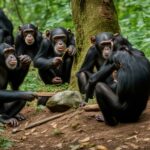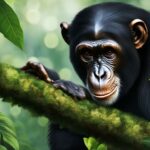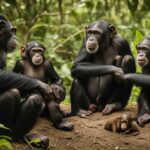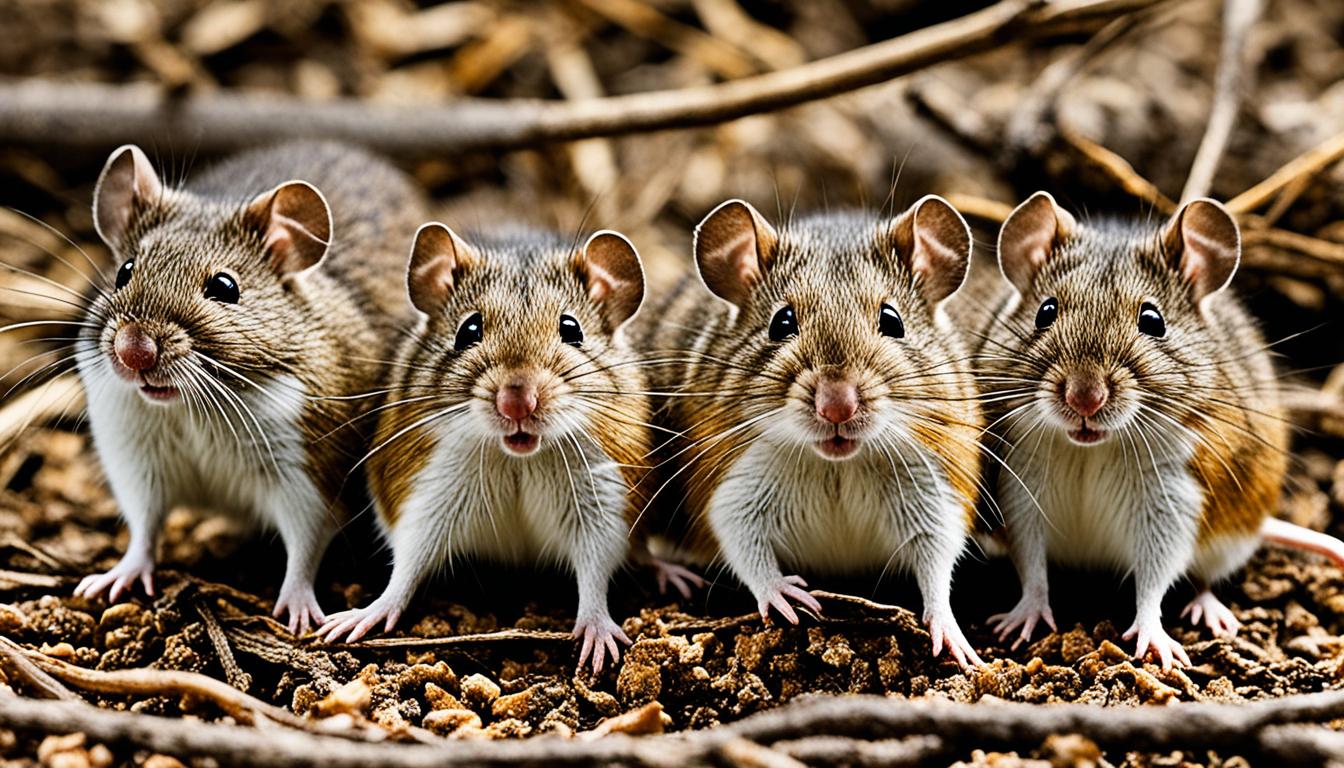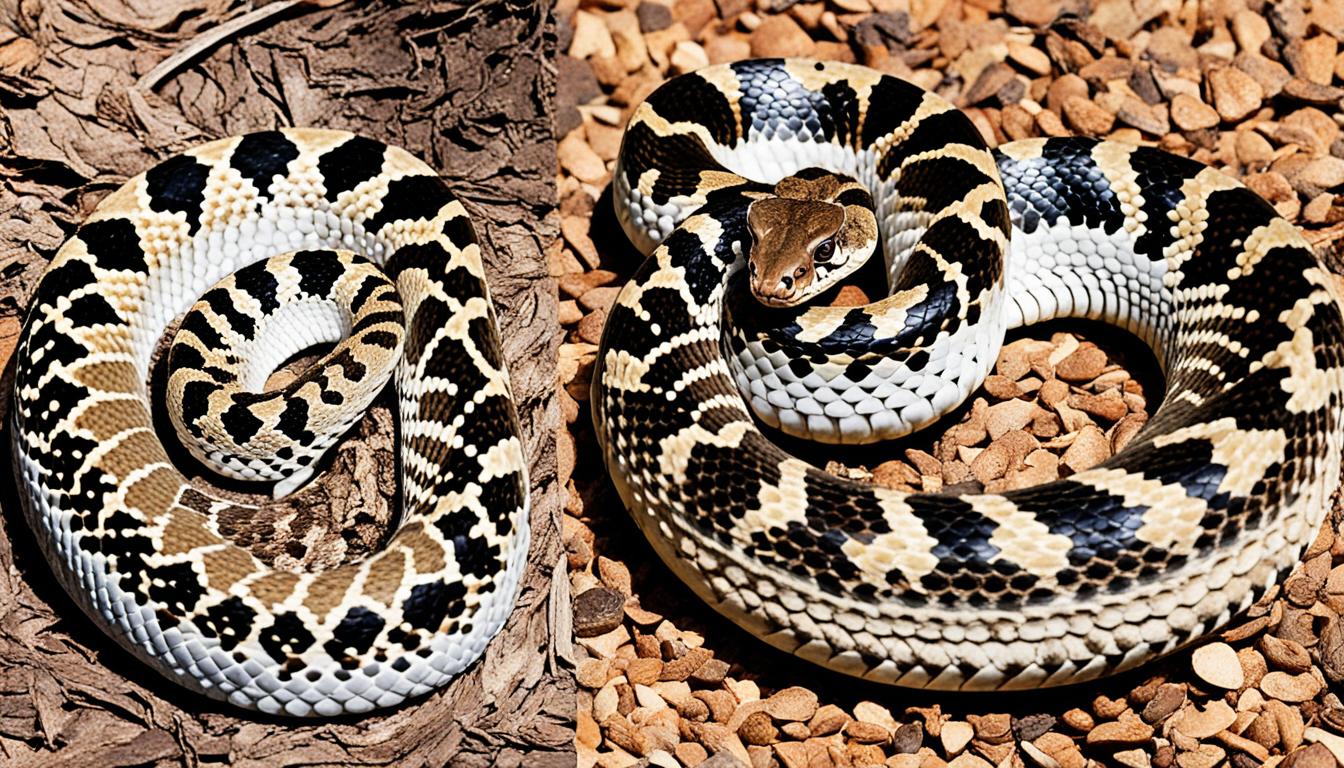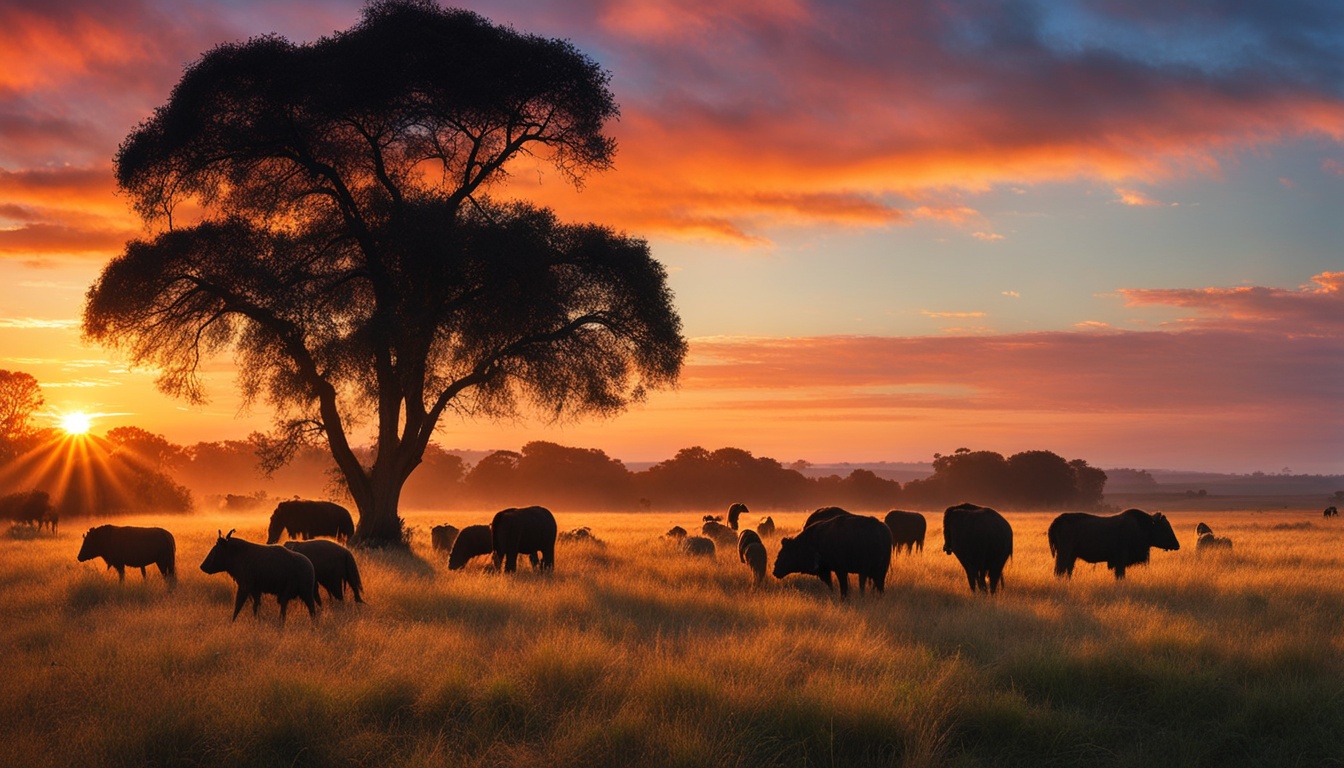Chimpanzees, our closest living relatives in the animal kingdom, have exhibited fascinating behaviors and adaptation strategies when faced with wildfires in their habitats. These remarkable creatures display an exceptional ability to predict and understand the behavior of fires, allowing them to respond accordingly. This behavior not only sheds light on the potential fire control abilities of our early ancestors but also provides valuable insights into the impact of wildfires on chimpanzee behavior.
Chimpanzees’ Fire Dance
| Chimpanzees’ Fire Dance | Key Points |
|---|---|
| Unique Adaptation | The fire dance is a distinctive behavior observed only in chimpanzees. |
| Exaggerated Displays | Chimpanzees showcase dominance towards the fire through exaggerated movements and vocalizations. |
| Distinct Vocalization | The alpha male often produces a distinct vocalization during the fire dance, leading the group. |
| Understanding and Adaptation | The fire dance demonstrates chimpanzees’ understanding of fire and their ability to adapt to wildfires in their habitats. |
Chimpanzees’ Ability to Control Fire
While chimpanzees have shown an impressive understanding and adaptation to wildfires, their ability to control fire is still limited. They have mastered the first stage of human fire control – understanding fire behavior and predicting its movement. However, starting and controlling a fire requires a level of dexterity that chimpanzees may not possess. Nonetheless, their intellectual abilities suggest that, given the right conditions and tools, they could potentially learn to control fire. The impact of wildfires on chimpanzee habitats highlights the importance of conservation efforts to protect these endangered species.
“Chimpanzees have demonstrated remarkable intelligence and adaptation when it comes to wildfires. However, their inability to control fire emphasizes the need for conservation measures to safeguard their habitats.”
Chimpanzees, being highly intelligent primates, have developed a profound understanding of fire behavior and its potential threat to their habitats. They can accurately predict the movement of wildfires and take appropriate actions to avoid the flames. The devastating impact of wildfires on chimpanzee habitats cannot be underestimated. These natural disasters not only destroy the physical landscape but also threaten the survival of these incredible creatures.
The Importance of Chimpanzee Conservation
Conservation efforts are essential to protect chimpanzee populations and their habitats from the destructive forces of wildfires. The devastation caused by these fires can lead to the displacement and even extinction of chimpanzee communities. By preserving their habitats and implementing proactive measures to prevent wildfires, we can ensure the continued existence of these remarkable creatures.
Protecting chimpanzee habitats from wildfires involves a comprehensive approach that includes:
- Implementing firebreaks to control the spread of fires
- Enforcing strict regulations against activities that could cause wildfires, such as improper disposal of cigarette butts or campfires
- Collaborating with local communities to raise awareness about the importance of preserving chimpanzee habitats and the devastating consequences of wildfires
- Supporting organizations and initiatives focused on chimpanzee conservation and habitat restoration
These conservation efforts not only benefit chimpanzees but also contribute to the preservation of biodiversity and the overall health of ecosystems.
Early human evolution and fire control
The ability of chimpanzees to understand and adapt to wildfires provides invaluable insights into the early evolution of fire control in our human ancestors. Researchers speculate that the understanding and control of fire played a crucial role in the development of key characteristics observed in early Homo, such as smaller teeth, smaller guts, increased body size, and decreased sexual dimorphism.
Chimpanzee behaviors, observed during wildfires, suggest that fire control could have emerged at an early stage in human evolution, shaping our physiological and behavioral characteristics. By studying the remarkable adaptability of chimpanzees in the face of wildfires, we can gain a deeper understanding of how our ancestors may have navigated and harnessed fire’s power.
This understanding allows us to explore the potential impact of wildfires on chimpanzee behavior, including their survival strategies and the broader implications for human development.
Through careful analysis of both physical and behavioral adaptations, scientists can delineate the role fire played in the shaping of our early ancestors’ lives. With a keen understanding of the impact of wildfires on chimpanzee behavior, we can gain insights into the evolutionary significance of fire control in our human lineage.
Implications for early human evolution:
The observed adaptability of chimpanzees indicates that the control of fire, and the utilization of its benefits, may have catalyzed the development of our species. Fire control provided early humans with warmth, protection from predators, and the ability to process, cook, and preserve food. These advantages allowed for the allocation of energy to other activities, such as socialization and tool development, ultimately playing a pivotal role in the advancement of human culture.
Understanding fire control in the context of early human evolution:
Archeological evidence points to the use of fire by early hominins. However, debate still exists regarding the timing and origin of fire control. Some propose evidence of fire use in Africa, dating back to 1.7-1.4 million years ago, while others suggest later dates in Europe and the Levant, around 400-350 thousand years ago. By examining the behaviors of chimpanzees during wildfires, researchers can make connections to our ancestors’ abilities to control and manipulate fire.
A comparison of chimpanzee survival during wildfires and fire control in early humans
| Chimpanzee Survival During Wildfires | Fire Control in Early Humans |
|---|---|
| Chimpanzees demonstrate an innate ability to predict and understand fire behavior. | Early humans likely acquired knowledge of fire behavior through observation and experimentation. |
| Chimpanzees exhibit calm behavior and expertly avoid approaching flames during wildfires. | Early humans developed techniques and tools to ignite and control fire, harnessing its benefits for survival. |
| Chimpanzees’ understanding of fire movement and ability to adapt contribute to their survival during wildfires. | Fire control in early humans facilitated improved safety, warmth, and access to cooked and preserved food resources. |
Fire use and foraging behavior
The presence of fire in chimpanzee habitats has a significant impact on their foraging behavior. Studies have shown that low-intensity grass fires create positive foraging opportunities for various species, including chimpanzees. The fire removes the vegetative understory, making movement faster and easier, while also exposing otherwise concealed resources such as fallen fruits and seeds.
Additionally, the heat from the fire can alter the structure of protective shells, making nutrient extraction easier for the chimpanzees. As a result, chimpanzees in burned areas are likely to pursue these resources at a higher rate, taking advantage of the post-fire landscape.
However, it is important to note that the overall impact of fire on chimpanzee foraging behavior is still an area of ongoing research. Scientists are investigating the specific changes in foraging strategies and preferences in response to fire, as well as the long-term effects of repeated fires on the availability and quality of food resources.
The image above illustrates the impact of fire on chimpanzee foraging behavior. The altered landscape after a fire provides new opportunities for chimpanzees to access previously inaccessible resources, leading to changes in their foraging patterns.
The timing and origin of fire control in humans
The timing and origin of fire control in human evolution have long been debated by archaeologists. There are different theories regarding the use of fire by early human ancestors, with some proposing early evidence of fire use in Africa dating back 1.7-1.4 million years ago, while others suggest later dates around 400-350 thousand years ago in Europe and the Levant.
These differing viewpoints highlight the challenges in establishing a precise timeline for the control of fire in humans. Further research is needed to uncover more evidence and determine the evolutionary drivers behind the development of fire control in our species.
One line of evidence supporting the early control of fire is the physiological and morphological alterations observed in early hominins like Homo erectus. These adaptations, such as smaller teeth and guts, increased body size, and decreased sexual dimorphism, suggest a shift towards a diet of cooked foods enabled by fire control.
However, the exact timing and mechanisms of fire control in humans remain uncertain. Ongoing research continues to shed light on this fascinating aspect of our evolutionary history.
Implications for understanding ancestral fire use
Studying the behavior of chimpanzees in response to wildfires provides valuable insights into the ancestral use of fire. Chimpanzees’ ability to predict and adapt to fires, their fire dances, and the impact of fire on their foraging behavior offer clues about how early hominins might have responded to wildfires in their habitats. By drawing comparisons between the behavior of chimpanzees and early humans, researchers can gain a better understanding of the evolution and significance of fire control in our species’ history.
Chimpanzees, like early hominins, have learned to anticipate the behavior and movement of fires. Their calm response to wildfires suggests a long history of living alongside fire and utilizing its benefits. The fire dances performed by chimpanzees not only demonstrate their cognitive abilities but also hint at a deep-rooted connection between fire and social behaviors in both our species and our ancestors.
Furthermore, observing the impact of fire on chimpanzee foraging behavior provides significant insights into the potential impact of ancestral fire use on early human diets and resource exploitation. As chimpanzees selectively forage in burned areas for exposed fruits, nuts, and seeds, we can infer that early hominins likely employed similar strategies to enhance their access to food resources.
Overall, the study of chimpanzee behavior in response to wildfires illuminates the ancient origins of fire use in our species. By unraveling the behavioral adaptations and ecological consequences associated with ancestral fire use, we gain a better understanding of our evolutionary journey and appreciate the profound role that fire has played in shaping our species’ history.
Do Wildfires in Chimpanzee Habitats Exacerbate the Effects of Climate Change?
Wildfires in chimpanzee habitats can exacerbate the effects of climate change by destroying valuable forest ecosystems. This can lead to habitat loss for chimpanzees and further contribute to the destruction of natural carbon sinks. Preserving these habitats is crucial for the conservation of both chimpanzees and climate change mitigation efforts.
Do chimpanzees also build nests for rest like gorillas, and how do they respond to wildfires in their habitats?
Yes, chimpanzees also build nests for rest, similar to gorillas’ nest building habits. They construct these nests in trees using branches and leaves. When faced with wildfires, chimpanzees exhibit varying responses based on their understanding and quick decision-making abilities to relocate to safer areas or seek refuge from the flames.

